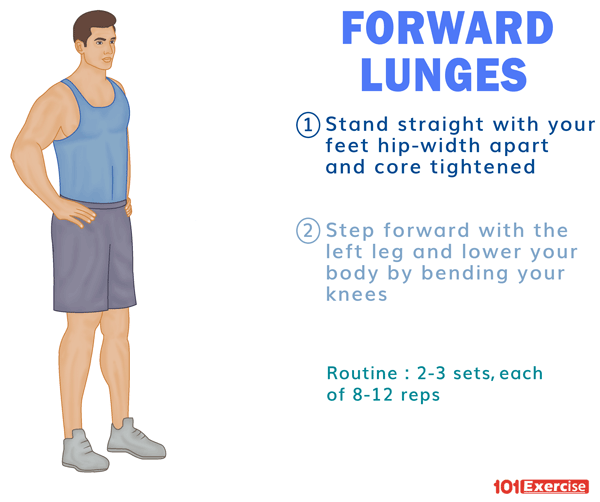Forward Lunges
Forward lunges are a bodyweight exercise performed by kneeling on one knee thereby working your hips, quads, glutes, inner-thigh, hamstrings, and core. Usually performed by athletes to improve their balance and make their muscle more flexible, it can also be used to gain strength so that you can perform everyday chores easily.
Benefits: What are Forward Lunges Good for
- Mimics your walking pattern and is suitable for beginners.
- Helps you find and correct muscle imbalance.
- Useful for improving core stability for those who are not comfortable with lifting the weight.
- Tones up gluteal muscles that are usually left unused during other workouts.
Lunges Vs. Squats
While both the lunge and squat activate quads, glutes, and hamstrings, a single leg exercise like the lunge works the gluteus muscle more than the squat. You may lean forward slightly while doing the lunge workout to activate your glutes and hamstrings more. On the other hand, assuming a slightly upright position would allow you to engage your quads more. Altering your squatting position also allows you to activate different muscle groups. Keeping your thighs parallel to the ground uses mostly quads while taking a wider stance or going lower engages more hamstrings and glutes.
How to do Forward Lunges
Start the exercise by standing upright with hip-width stance, shoulders back, and your core tightened. Step forward with your right leg, shifting the weight forward so that the heel touches the floor first. Descend your thighs until they are bent at an angle of 90 degrees. You may let your left knee tap the floor while keeping the weight in your right heel. Drive through your right heel back to the initial position before performing the same movement on the other side.
Tips
- Do not keep your front foot in a straight line with the back foot, as it will narrow your stance and make the movement more difficult.
- While shifting your weight forward, do not allow the upper body to drop to keep yourself from putting a strain on the knee.
- Keep your abs pulled in to keep your hips from sagging forward.
- If your knees hurt, take smaller steps than you would normally do while performing a lunge.
Variations
- Alternating Lunges: Performed by alternating back and forth, lunging forward with one leg and then with the other.
- Deep Lunges: Involves bending one of the legs forward while leaving the other leg straight and bringing its hips as low as possible.
- Static Lunge: Done by holding your position, e., standing with one of the feet forward and the other one back.
- Elevated Lunges: Performed by keeping either your front or rear foot elevated on a low box while in a static position.
- Curtsy Lunges: Involves crossing your right leg over the left while lunging back as far as possible to your left side and then doing the same movement on the right side.
- Lunges on Smith Machine: Requires setting up a smith machine so that the bar is on your traps while you stand with a split stance.
Alternative Exercises
- Squats
- Barbell Deadlifts

